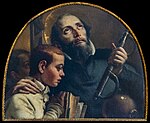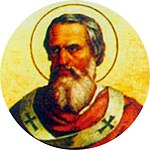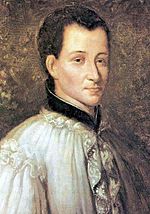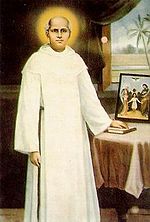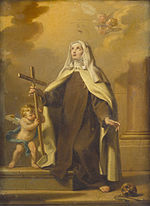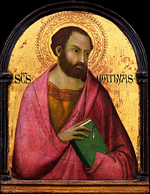Portal:Catholic Church/Patron Archive/February
Patron Archive
January - February - March - April - May - June - July - August - September - October - November - December
Today is Sunday, April 28, 2024; it is now 03:44 UTC
February 1[edit]
Saint Brigid of Kildare or Saint Brigid of Ireland (Irish: Naomh Bríd; Classical Gaelic: Brighid; Latin: Brigida; c. 451 – 525) is the patroness saint (or 'mother saint') of Ireland, and one of its three national saints along with Patrick and Columba. According to medieval Irish hagiographies, she was an abbess who founded the important abbey of Kildare (Cill Dara), as well as several other convents of nuns. There are few historical facts about her, and her hagiographies are mainly anecdotes and miracle tales, some of which are rooted in pagan folklore. They say Brigid was the daughter of a chieftain and a slave woman, and was raised in a druid's household before becoming a consecrated virgin. She is patroness of many things, including poetry, learning, healing, protection, blacksmithing, livestock and dairy production. In her honour, a perpetual fire was kept burning at Kildare for centuries.
Some historians suggest that Brigid is a Christianisation of the Celtic goddess Brigid. The saint's feast day is 1 February, and traditionally it involves weaving Brigid's crosses and many other folk customs. It was originally a pre-Christian festival called Imbolc, marking the beginning of spring. From 2023 it is a public holiday in the Republic of Ireland. This feast day is shared by Dar Lugdach, who tradition says was her student, close companion, and successor. (Full article...)
Prayer: "Christus in nostra insula Que vocatur Hivernia Ostensus est hominibus Maximis mirabilibus Que perfecit per felicem Celestis vite virginem Precellentem pro merito Magno in numdi circulo."
Attributes: an abbess with a shepherd's staff and flames over her head, with a lamp or candle, sometimes with a cow, ducks or gooses
Patronage: babies; blacksmiths; boatmen; cattle; chicken farmers; children whose parents are not married; dairymaids; dairy workers; fugitives; infants; Ireland; Leinster, Ireland; mariners; midwives; milk maids; newborn babies; nuns; poets; poultry farmers; poultry raisers; printing presses; sailors; scholars; travellers; watermen
See also: Henry Morse, England
February 2[edit]
Cornelius (Greek: Κορνήλιος, romanized: Kornélios; Latin: Cornelius) was a Roman centurion who is considered by some Christians to be the first Gentile to convert to the faith, as related in Acts of the Apostles (see Ethiopian eunuch for the competing tradition). The baptism of Cornelius is an important event in the history of the early Christian church. He may have belonged to the gens Cornelia, a prominent Roman family. (Full article...)
Attributes: Roman military garb
Patronage: -
See also: Saint Maria Katharina Kasper
February 3[edit]
Blaise of Sebaste (Armenian: Սուրբ Վլասի, Surb Vlasi; Greek: Ἅγιος Βλάσιος, Hágios Blásios; Latin: Blasius martyred 316 AD) was a physician and bishop of Sebastea in historical Lesser Armenia (modern Sivas, Turkey) who is venerated as a Christian saint and martyr. He is counted as one of the Fourteen Holy Helpers.
Blaise is a saint in the Catholic, Western Rite Orthodoxy, Eastern Orthodox and Oriental Orthodox Churches and is the patron saint of wool combers and of sufferers from ENT illnesses. In the Latin Church, his feast falls on 3 February. In the Eastern Churches, it is on 11 February. According to the Acta Sanctorum, he was martyred by being beaten, tortured with iron combs, and beheaded. (Full article...)
Prayer: O God, deliver us through the intercession of Thy holy bishop and martyr Blase, from all evil of soul and body, especially from all ills of the throat; and grant us the grace to make a good confession in the confident hope of obtaining Thy pardon, and ever to praise with worthy lips Thy most holy name. Through Christ our Lord. Amen.
Attributes: Wool comb, candles, tending a choking boy or animals
Patronage: Animals, builders, drapers, choking, veterinarians, throats, infants; Bradford, England; Maratea, Italy; Sicily; Dubrovnik; Ciudad del Este, Paraguay; Campanário, Madeira; Rubiera; stonecutters, carvers, wool workers
See also: Ansgar; Claudine Thévenet, France
February 4[edit]
Andrea Corsini (30 November 1302 – 6 January 1373 or 1374) was an Italian Catholic prelate and professed member from the Carmelites who served as the Bishop of Fiesole from 1349 until his death.
Corsini led a wild and dissolute life until a rebuke from his mother moved him to go to the Santa Maria del Carmine church where he resolved to join the Carmelites as a priest and friar. He exercised various roles in the order, until reluctantly he accepted his episcopal position. In order to accept that position, he imposed greater mortifications upon himself than that required by the order, and dedicated himself to the plight of the poor. (Full article...)
Prayer: God our Father, you reveal that those who work for peace will be called your children. Through the prayers of St Andrew Corsini, who excelled as a peacemaker help us to work without ceasing for that justice which brings truth and lasting peace. We ask this through Christ, Our Lord. Amen.
Attributes: Holding a cross; wolf and lamb at his feet; floating on cloud above battlefield; Mitre; episcopal attire; Carmelite habit
Patronage: Florence; Fiesole; diplomats; against civil disorder; against riots
See also: Isidore of Pelusium; Joan of France, Duchess of Berry; John de Britto
February 5[edit]
Agatha of Sicily (c. 231 – 251 AD) is a Christian saint. Her feast is on 5 February. Agatha was born in Catania, part of the Roman Province of Sicily, and was martyred c. 251. She is one of several virgin martyrs who are commemorated by name in the Canon of the Mass. (Full article...)
Prayer. Dear Virgin and Martyr, whom the Church recalls in her liturgy, you heroically resisted the temptations of a degenerate ruler. Subjected to long and horrible tortures, you remained faithful to your heavenly Spouse. Saint Peter, we are told, gave you some solace and so you are invoked by nurses. Encourage them to see Christ in the sick and to render true service to them. Amen.
Attributes: shears, tongs, breasts on a plate
Patronage: Sicily; bellfounders; breast cancer; bakers; Catania, Sicily; against fire; earthquakes; eruptions of Mount Etna; fire; jewelers; martyrs; natural disasters; nurses; Palermo, Sicily; rape victims; San Marino; single laywomen; sterility; torture victims; volcanic eruptions; wet nurses; Zamarramala, Spain, Malta
See also: Adelaide, Abbess of Vilich, Germany
February 6[edit]
Amandus (c. 584 – 679), commonly called Saint Amand, was a bishop of Tongeren-Maastricht and one of the catholic missionaries of Flanders. He is venerated as a saint, particularly in France and Belgium. (Full article...)
Attributes: Chair, church, flag
Patronage: Wine makers, Beer brewers, merchants, innkeepers, bartenders
See also: 26 Martyrs of Japan; Saint Paulo Miki; Alfonso Maria Fusco; Francesco Spinelli
February 7[edit]
Richard the Pilgrim or Richard of Wessex (died 720) was the father of the West Saxon saints Willibald, Winnibald, and Walpurga. He led his family on a pilgrimage to the Holy Land but died en route in Lucca, where he was buried in the church of Saint Fridianus. (Full article...)
Attributes: -
Patronage: -
See also: Egidio Maria of Saint Joseph
February 8[edit]
Gerolamo Emiliani, CRS (Italian: Gerolamo Emiliani also Jerome Aemilian, Hiëronymus Emiliani) (1486 – 8 February 1537) was an Italian humanitarian, founder of the Somaschi Fathers, and is considered a saint by the Catholic Church.
Born in Venice, he spent some time in the military, and later served as a magistrate. Emiliani provided for the sick, the hungry, and orphans; and persuaded others to do likewise. Through his good offices a number of hospitals and orphanages were established in several northern Italian towns. He was canonized in 1767 and is the patron saint of orphans. (Full article...)
Prayer: Saint Jerome Emiliani, watch over all children who are abandoned or unloved. Give us the courage to show them God's love through our care. Help us to lose the chains that keep us from living the life God intended for us. Amen
Attributes: -
Patronage: orphans, abandoned children
See also: Josephine Bakhita
February 9[edit]
Saint Apollonia (Greek: 'Αγία Απολλωνία, Coptic: Ϯⲁⲅⲓⲁ Ⲁⲡⲟⲗⲗⲟⲛⲓⲁ) was one of a group of virgin martyrs who suffered in Alexandria during a local uprising against the Christians prior to the persecution of Decius. According to church tradition, her torture included having all of her teeth violently pulled out or shattered. For this reason, she is popularly regarded as the patroness of dentistry and those suffering from toothache or other dental problems. French court painter Jehan Fouquet painted the scene of St. Apollonia's torture in The Martyrdom of St. Apollonia. (Full article...)
Attributes: Tongs (sometimes with a tooth in them), depicted holding a cross or martyr's palm or crown
Patronage: Dentists; Tooth problems; Elst, Belgium; Ariccia, Italy; Cuccaro Monferrato, Italy
See also: Rosa Francisca Dolors Molas Vallvé, Spain; Miguel Febres Cordero, Ecuador
February 10[edit]
Scholastica (c. 480 – 10 February 543) was an Italian Christian hermit and the sister of Benedict of Nursia. She is traditionally regarded as the foundress of the Benedictine nuns.
Scholastica is honored as a saint of the Catholic Church, Eastern Orthodox Church and Anglican Communion. She was born in Italy, and a ninth-century tradition makes her the twin sister of Benedict. Her feast day is 10 February. (Full article...)
Prayer: O God, to show us where innocence leads, you made the soul of your virgin Saint Scholastica soar to heaven like a dove in flight. Grant through her merits and her prayers that we may so live in innocence as to attain to joys everlasting. This we ask through our Lord.
Attributes: nun with crozier and crucifix; nun with dove flying from her mouth
Patronage: Patroness of Benedictine women's communities; school; tests; books; reading; convulsive children; nuns; invoked against storms and rain; Le Mans
See also: José Sánchez del Río, Mexico
February 11[edit]
Pope Paschal I (Latin: Paschalis I; died 824) was the bishop of Rome and ruler of the Papal States from 25 January 817 to his death in 824.
Paschal was a member of an aristocratic Roman family. Before his election to the papacy, he was abbot of St. Stephen's monastery, which served pilgrims. In Rome in 823 he crowned Lothair I as Holy Roman Emperor. He rebuilt a number of churches in Rome, including three basilicas. (Full article...)
Attributes: Papal vestments, Pallium
Patronage: -
See also: Our Lady of Lourdes
February 12[edit]
Eulalia (c. 289 – February 12, 303), co-patron saint of Barcelona, was a 13-year-old Roman Christian virgin who was martyred in Barcelona during the persecution of Christians in the reign of emperor Diocletian (although the Sequence of Saint Eulalia mentions the "pagan king" Maximian). There is some dispute as to whether she is the same person as Eulalia of Mérida, whose story is similar. (Full article...)
Attributes: X-shaped cross, stake, and dove
Patronage: Barcelona, Spain; sailors; against drought
Benedict of Aniane (Latin: Benedictus Anianensis; German: Benedikt von Aniane; c. 747 – 12 February 821 AD), born Witiza and called the Second Benedict, was a Benedictine monk and monastic reformer, who left a large imprint on the religious practice of the Carolingian Empire. His feast day is either February 11 or 12, depending on liturgical calendar. (Full article...)
Attributes: -
Patronage: -
February 13[edit]
Catherine de' Ricci, OP (Italian: Caterina de' Ricci) (23 April 1522 – 2 February 1590), was an Italian Catholic nun in the Third Order of St. Dominic. She is believed to have had miraculous visions and corporeal encounters with Jesus Christ. She is also said to have spontaneously bled with the wounds of the crucified Christ. She is venerated for her mystic visions and is venerated as a saint by the Catholic Church. (Full article...)
Attributes: -
Patronage: The sick
February 14[edit]
Saint Valentine (Italian: San Valentino; Latin: Valentinus) was a 3rd-century Roman saint, commemorated in Western Christianity on February 14 and in Eastern Orthodoxy on July 6. From the High Middle Ages, his feast day has been associated with a tradition of courtly love. He is also a patron saint of Terni, epilepsy and beekeepers.
Saint Valentine was a clergyman – either a priest or a bishop – in the Roman Empire who ministered to persecuted Christians. He was martyred and his body buried on the Via Flaminia on February 14, which has been observed as the Feast of Saint Valentine (Saint Valentine's Day) since at least the eighth century.
Relics of him were kept in the Church and Catacombs of San Valentino in Rome, which "remained an important pilgrim site throughout the Middle Ages until the relics of St. Valentine were transferred to the church of Santa Prassede during the pontificate of Nicholas IV". His skull, crowned with flowers, is exhibited in the Basilica of Santa Maria in Cosmedin, Rome. Other relics of him are in Whitefriar Street Carmelite Church, Dublin, Ireland, a popular place of pilgrimage, especially on Saint Valentine's Day, for those seeking love. At least two different Saint Valentines are mentioned in the early martyrologies. For Saint Valentine of Rome, along with Saint Valentine of Terni, "abstracts of the acts of the two saints were in nearly every church and monastery of Europe", according to Professor Jack B. Oruch of the University of Kansas. (Full article...)
Attributes: Birds; roses; bishop with a disability or a child with epilepsy at his feet; bishop with a rooster nearby; bishop refusing to adore an idol; bishop being beheaded; priest bearing a sword; priest holding a sun; priest giving sight to a blind girl
Patronage: Affianced couples, against fainting, beekeepers, happy marriages, love, plague, epilepsy
See also: Saints Cyril and Methodius; Juan García López-Rico, Spain
February 15[edit]
Claude La Colombière, S.J. was a French Jesuit priest best known as the confessor of Margaret Mary Alacoque. He is venerated as a saint in the Catholic Church.
His feast day is the day of his death, 15 February. He was a missionary and ascetical writer. Colombière left a large number of writings, including his principal works, Pious Reflections, Meditations on the Passion, and Retreat and Spiritual Letters. (Full article...)
Attributes: -
Patronage: Devotion to the Sacred Heart of Jesus
February 16[edit]
Juliana of Nicomedia (Greek: Ίουλιανή Νικομηδείας) is an Anatolian Christian saint, said to have suffered martyrdom during the Diocletianic persecution in 304. She was popular as a patron saint of the sick during the Middle Ages, especially in the Netherlands. (Full article...)
Attributes: Represented in pictures with a winged devil whom she leads by a chain. She is also shown enduring various tortures or fighting a dragon.
Patronage: sickness
February 17[edit]
Evermode, or Evermod (c. 1100 – 17 February 1178), was one of the first Premonstratensian canons regular, and became the lifelong companion of Norbert of Xanten, who founded the order in France in 1120. (Full article...)
Attributes: -
Patronage: -
See also: Seven Holy Founders of the Servite Order
February 18[edit]
Kuriakose Elias Chavara, CMI (10 February 1805 – 3 January 1871) was an Indian Syro-Malabar Catholic priest, religious, philosopher and social reformer. He is the first canonised Catholic male saint of Indian origin and was a member of the Syro-Malabar Church, an Eastern Catholic church.
He was the co-founder and first prior general of the first congregation for men in the Syro-Malabar Church, the Carmelites of Mary Immaculate (CMI), and of a similar one for women, the Congregation of the Mother of Carmel (CMC). (Full article...)
Attributes: Catholic saint, founder and social reformer
Patronage: Press industry, media, literature, congregations
See also: Simeon of Jerusalem; Geltrude Comensoli
February 19[edit]
Barbatus of Benevento (Italian: San Barbato) (c. 610 – February 19, 682), also known as Barbas, was a bishop of Benevento from 663 to 682. He succeeded Ildebrand in this capacity. He assisted in a church council called by Pope Agatho in Rome in 680 and in 681 attended the Third Council of Constantinople against the Monothelites. (Full article...)
Attributes: Crozier
Patronage: Benevento
February 20[edit]
Francisco de Jesus Marto (11 June 1908 – 4 April 1919) and Jacinta de Jesus Marto (5 March 1910 – 20 February 1920) were siblings from Aljustrel, a small hamlet near Fátima, Portugal, who, with their cousin Lúcia dos Santos (1907–2005), reportedly witnessed three apparitions of the Angel of Peace in 1916, and several apparitions of the Blessed Virgin Mary at Cova da Iria in 1917. The title Our Lady of Fátima was given to the Virgin Mary as a result, and the Sanctuary of Fátima became a major centre of world Christian pilgrimage.
The two Marto children were solemnly canonized by Pope Francis at the Sanctuary of Our Lady of Fátima, in Portugal, on 13 May 2017, the centennial of the first Apparition of Our Lady of Fátima. They are the youngest Catholic saints, with Jacinta being the youngest saint who did not die a martyr. (Full article...)
Attributes: -
Patronage: Bodily ills, Portuguese children, Captives, People ridiculed for their piety, Prisoners, Sick people, Against sickness
See also: Eucherius of Orléans
February 21[edit]
Peter Damian, OSB (Latin: Petrus Damianus; Italian: Pietro or Pier Damiani; c. 1007 – 21 or 22 February 1072 or 1073) was an Italian reforming Benedictine monk and cardinal in the circle of Pope Leo IX. Dante placed him in one of the highest circles of Paradiso as a great predecessor of Francis of Assisi and he was declared a Doctor of the Church on 27 September 1828. His feast day is 21 February. (Full article...)
Attributes: represented as a cardinal bearing a knotted rope in his hand; also as a pilgrim holding a papal Bull; Cardinal's hat, Benedictine monk's habit
Patronage: -
See also: Robert Southwell
February 22[edit]
Margaret of Cortona (1247 – 22 February 1297) was an Italian penitent of the Third Order of Saint Francis. She was born in Laviano, near Perugia, and died in Cortona. She was canonised in 1728.
She is the patroness saint of reformed prostitutes; the falsely accused, hoboes, homeless, insane, orphaned, mentally ill, midwives, penitents, single mothers, stepchildren, and tramps. (Full article...)
Attributes: Tender of the sick
Patronage: Against temptations; falsely accused people; homeless people; insanity; loss of parents; mental illness; mentally ill people; midwives; penitent women; single mothers; people ridiculed for their piety; reformed prostitutes; sexual temptation; single laywomen; third children
See also: Papias of Hierapolis
February 23[edit]
Polycarp (/ˈpɒlikɑːrp/; Greek: Πολύκαρπος, Polýkarpos; Latin: Polycarpus; AD 69 – 155) was a Christian bishop of Smyrna. According to the Martyrdom of Polycarp, he died a martyr, bound and burned at the stake, then stabbed when the fire failed to consume his body. Polycarp is regarded as a saint and Church Father in the Catholic Church, Eastern Orthodox Church, Oriental Orthodox Churches, Lutheranism, and Anglicanism.
Both Irenaeus and Tertullian say that Polycarp had been a disciple of John the Apostle, one of Jesus's disciples. In On Illustrious Men, Jerome writes that Polycarp was a disciple of John the Apostle and that John had ordained him as a bishop of Smyrna. Polycarp is regarded as one of three chief Apostolic Fathers, along with Clement of Rome and Ignatius of Antioch. (Full article...)
Attributes: Wearing the pallium, holding a book representing his Epistle to the Philippians
Patronage: -
See also: Giuditta Vannini
February 24[edit]
Matthias (/məˈθaɪəs/; Koine Greek: Μαθθίας, Maththías [maθˈθi.as], from Hebrew מַתִּתְיָהוּ Mattiṯyāhū; Coptic: ⲙⲁⲑⲓⲁⲥ; died c. AD 80) was, according to the Acts of the Apostles, chosen by God through the apostles to replace Judas Iscariot following the latter's betrayal of Jesus and his subsequent death. His calling as an apostle is unique, in that his appointment was not made personally by Jesus, who had already ascended into heaven, and it was also made before the descent of the Holy Spirit upon the early Church. (Full article...)
Attributes: axe, Christian martyrdom
Patronage: alcoholics; carpenters; tailors; Gary, Indiana; Great Falls-Billings, Montana; smallpox; hope; perseverance
February 25[edit]
Tarasios of Constantinople (also Saint Tarasios and Saint Tarasius; Greek: Ταράσιος; c. 730 – 25 February 806) was the Ecumenical Patriarch of Constantinople from 25 December 784 until his death on 25 February 806. (Full article...)
Attributes: Vested as a bishop with omophorion often holding a Gospel book with his right hand raised in blessing
Patronage: -
See also: Gerland of Agrigento; Luigi Versiglia
February 26[edit]
Isabelle of France (March 1225 – 23 February 1270) was a French princess and daughter of Louis VIII of France and Blanche of Castile. She was a younger sister of King Louis IX of France (Saint Louis) and of Alfonso, Count of Poitiers, and an older sister of King Charles I of Sicily. In 1256, she founded the nunnery of Longchamp in part of the Forest of Rouvray (now called the Bois de Boulogne), west of Paris. Isabelle consecrated her virginity and her entire life to God alone. She is honored as a saint by the Franciscan Order. Her feast day is 22 February. (Full article...)
Attributes: -
Patronage: Patroness of the sick
See also: Pope Alexander I of Alexandria; Paula Montal Fornés, Spain
February 27[edit]
Gabriel of Our Lady of Sorrows (born Francesco Possenti 1 March 1838 – 27 February 1862) was an Italian Passionist clerical student. Born to a professional family, he gave up ambitions of a secular career to enter the Passionist congregation. His life in the monastery was not extraordinary, yet he followed the rule of the congregation perfectly and was known for his great devotion to the sorrows of the Virgin Mary. He died from tuberculosis at the age of 23 in Isola del Gran Sasso, in the province of Teramo. He was canonized by Pope Benedict XV in 1920. (Full article...)
Attributes: Passionist Habit and Sign
Patronage: Students, Youth, Clerics, Seminarians, Abruzzi
See also: Gregory of Narek, Armenia
February 28[edit]
Pope Hilarius (also Hilarus, Hilary; died 29 February 468) was the bishop of Rome from AD 461 to 468.
In 449, Hilarius served as a legate for Pope Leo I at the Second Council of Ephesus. His opposition to the condemnation of Flavian of Constantinople incurred the enmity of Dioscurus of Alexandria, who attempted to prevent him from leaving the city. Hilarius was able to make his escape and returned to Rome by an indirect route. He later erected an oratory at the Lateran in honor of John the Evangelist, to whom he attributed his safe passage. (Full article...)
Attributes: -
Patronage: -
February 29[edit]
Oswald of Worcester (died 29 February 992) was Archbishop of York from 972 to his death in 992. He was of Danish ancestry, but brought up by his uncle, Oda, who sent him to France to the abbey of Fleury to become a monk. After a number of years at Fleury, Oswald returned to England at the request of his uncle, who died before Oswald returned. With his uncle's death, Oswald needed a patron and turned to another kinsman, Oskytel, who had recently become Archbishop of York. His activity for Oskytel attracted the notice of Archbishop Dunstan who had Oswald consecrated as Bishop of Worcester in 961. In 972, Oswald was promoted to the see of York, although he continued to hold Worcester also. (Full article...)
Attributes: -
Patronage: -
See also: John Cassian








